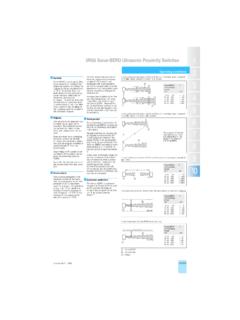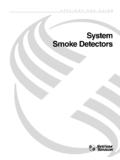Transcription of 3RG7 Opto-BERO Photoelectric Proximity Switches
1 3RG7 Opto-BERO Photoelectric Proximity Switches Description Opto-BEROs react to changes Reflex Sensors for fibre- Diffuse sensor of the received quantity of light. sensors optic conductors The emitted light beam will be interrupted or reflected by the object to be detected. Depend- ing on the type of BERO the The pulsed light from the trans- The basic operation is the same mitter diode is focused through for optical fibres made of glass a interruption or reflection of the light beam is evaluated. a lens and directed via a polar- or plastic. Optical fibres are fit- ization filter to a reflector (princi- ted in front of the transmitter and ple of a 3-way mirror). Part of the receiver. They represent the NSK-7329a reflected light passes through extended eye of the Opto- Available functions another polarization filter and BERO.
2 As fibre-optic conduc- Opto-BEROs are available as reaches the receiver. The filters tors are very small and flexible, Reflex sensor thru-beam sensors, reflex sen- are selected and adjusted in they form a truly practical solu- sors and diffuse sensors. such a way that only the light tion to the problem of sensing at Because of the different physi- reflected by the reflector points that are not easily acces- cal principles under otherwise reaches the receiver, not the sible. Furthermore, no electrical identical exterior conditions light from other objects within potential is transferred. the beam range. An object a thru-beam sensors have wider transmission ranges than reflex which interrupts the light beam from the transmitter through the Fork sensors sensors. Diffuse sensors can react also to diffuse-reflecting reflector to the receiver causes NSK-7330a materials.
3 So their sensing the output to switch. range is shorter than the sens- ing range of reflex sensors. Light array (7-beam reflex The object is introduced into the Thru-beam sensor sensor) fork of the BERO. The light of the sensor penetrates the object. Diffuse The light of the seven transmit- Different contrasts, cracks or sensors ters of this special Opto-BERO holes alter the quantity of light (energetic is directed to one reflector and which reaches the receiver. The sensor) a reflected to the seven receivers BERO reacts to the change in The pulsed light from the trans- of the BERO. An object which the amount of light received. mitter diode falls on an object. interrupts one of these seven It is reflected in a diffuse pat- light beams causes the output to NSK-7331a switch. A line of 42 mm can be Colour sensor tern and part of the light reaches the light receiver completely covered.
4 This type of located in the same unit. If the Opto-BERO can be used in intensity of light is sufficient, the conveyor systems. The colour sensor works with Clearance output is switched. The sensing range depends on the size and three LED's in red, green and The Opto-BERO may not inter- Thru-beam fere with each other. For this rea- colour of the object involved as sensors blue. This light shines onto the well as on its surface texture. object. When configuring the son a minimum distance a The sensing range can be var- BERO, the colour of the object is between 2 BEROs has to be ied within a wide range by measured and an output status observed. means of the built-in potentiom- They consist of a transmitter and is allocated. During the learning The following distances are rec- eter. Therefore, the energetic a receiver.
5 The transmitter is phase, the BERO saves the ommended values only. The val- sensor can be used for detect- aligned in such a way that the colour recognised in non-volatile ues given are for maximum sen- ing different colours. greatest possible amount of EEPROM. This means that the sitivity. pulsed light from the transmitter BERO does not need to be reset diode reaches the receiver. The every time the operating voltage Diffuse receiver evaluates the incoming is switched back on again. A BERO distance a sensors with light to clearly separate it from colour or a colour range can be background D 4/M 5 50 mm the ambient light and other light set. M 12 250 mm suppression sources. Any interruption of the M 18 250 mm Diffuse sensors with back- light beam between transmitter K 31 250 mm and receiver causes the output Print mark K 30 500 mm ground suppression can detect reader to switch.
6 K 40 750 mm objects up to a certain sensing K 80 500 mm range. All further objects will be L 18 150 mm1). suppressed. The focus level L 50 (diffuse sensor) 30 mm can be changed. The back- The print mark reader works with L 50 (thru-beam sensor) 80 mm ground suppression is done by a green or a red sender light. the geometrical constellation The colour is selected automati- between transmitter and cally as a function of the con- receiver. trast. There are two sensors, so the colour of the mark and the colour of the background can be set separately. 1) For focussing to 50 m. Siemens NS K 2000 10/127. 3RG7 Opto-BERO Photoelectric Proximity Switches Opto-BERO dictionary Adjustment (potentiometer) Ambient light limit Connection to AS-Interface Dark-ON. Sensitivity is adjusted by means Ambient light is the light pro- Data and parameter bit alloca- The Dark-ON function means of the built-in multi-turn potenti- duced by external light sources.
7 Tion that the output in question is ometer. Turning it clockwise The intensity of illuminance is switched through (current carry- increases the sensitivity. The measured on the light incidence Data bits Meaning ing), when light does not reach potentiometer cannot be over- surface. Due to the use of pul- D0 Switch signal the receiver. wound (no stops). sating light the sensors are basically insensitive to ambient D1 Function reserve Diffuse sensors Set the sensitivity and distance light. There is, nevertheless, an upper limit for the intensity of D2 Enabling input so that the object to be scanned any external light which is D3 Enabling input for Some Opto-BEROs are pro- is reliably detected. If required, referred to as the ambient light testing vided with a test input. In these the surplus light LED has to be limit.
8 It is indicated for sunlight 0: Transmitter on units the transmitter can be activated. Now remove the (unmodulated light) modulated 1: Transmitter off selectively switched on or off. object. If the output remains halogen light (light modulated at Through appropriate evaluation Parameter bits Meaning switched through, the sensitiv- double system frequency). A of the output signal the function- ity has to be reduced slightly. reliable operation of the units is P0 ing can be controlled. (reflex no longer possible if the illumi- and thru-beam sensors: no Reflex sensors / Thru-beam nance is above the relevant P1 Inversion of D0 obstruction of light beam/diffuse sensors ambient light limit. 0: Transmitter on sensor: reflection object exists). 1: Transmitter off The potentiometer is normally For disabling the BERO the set to maximum (turned clock- P2.)
9 Enabling input must be set to wise). This provides the maxi- Antivalent (outputs) P3 0 V. For operation of the BERO. mum surplus light function. A no switching of the enabling reduction of sensitivity may be Opto-BEROs have two outputs. One Switches dark-ON, the input is requiredysteresis required if transparent objects are to be detected. other light-ON. This configura- Correction factors tion is called antivalent. Alterna- (sensing range). tively some of the devices are The specified sensing ranges of Hysteresis available with a different config- Alignment uration of the outputs. One out- diffuse sensors are achieved Hysteresis (differential travel). put Switches light-ON, the other with the given surfaces by using causes a defined switching Diffuse sensors mat white standard paper. The behaviour in the units.
10 The spec- is for the surplus light function. The BERO is to be aligned correction factors stated below ified transmission range always towards the object to be apply to other surfaces (guid- refers to the switching point scanned in such a way as to ance values). when the sensor is being ensure reliable switching. If the Autocollimation approached. units have a surplus light func- For these units the optical axes Test card 100%. tion, the appropriate LED has to of transmitter and receiver are White paper 80%. be activated. the same. The device has only Grey PVC. Printed newspaper 57%. 60%. Installation Reflex sensors one optical system so that there is no close range in front of the Light-coloured wood 73% The units can be installed in any Place the reflector at the BERO and the accuracy of the Cork 65% position.







